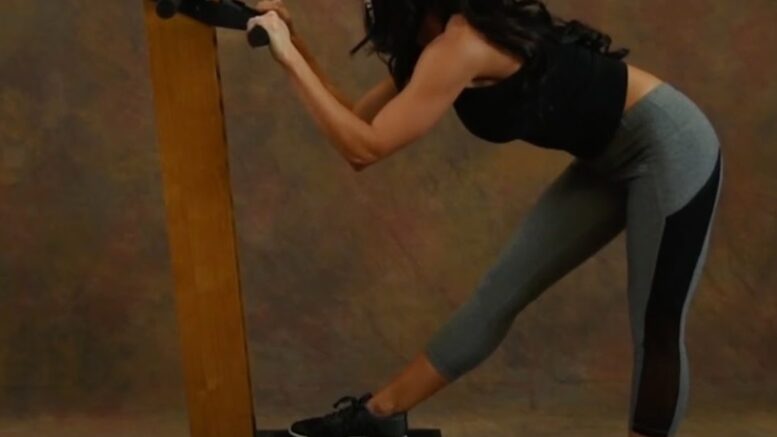Plantar fasciitis can be extremely painful, and some medical treatment options can be invasive as well. However, with proper natural stretching and exercise, it can be treated without too much difficulty.
In this article, we will explore various treatment options, including strengthening leg muscles, nonsteroidal anti-inflammatory drugs (NSAIDs), platelet-rich plasma (PRP), supportive shoes, night splints, physical therapy, and arch supports. Finally, we will discuss the promising results of exercise with vibration plates. These various treatments can help alleviate pain, reduce inflammation, and promote healing.
What is Plantar Fasciitis?
Plantar fasciitis is a common foot condition that involves inflammation of the plantar fascia, which is a thick band of tissue that runs along the bottom of the foot, connecting the heel bone to the toes. The plantar fascia acts as a shock absorber and supports the arch of the foot.
Plantar fasciitis typically causes pain in the heel or arch of the foot, especially with the first steps taken after a period of rest, such as in the morning or after sitting for a while. The pain is often described as a sharp, stabbing sensation. It can also be accompanied by stiffness, tenderness, and swelling in the affected area.
Medical Treatment for Plantar Fasciitis
Some medical treatments for plantar fasciitis can be difficult and painful, including injecting a long needle into the bottom of the foot. First, we’ll briefly discuss these options that include intervention with medical professionals.
Imaging Tests for Accurate Diagnosis
In some cases, imaging tests such as X-rays or ultrasound may be recommended to diagnose plantar fasciitis and rule out other possible conditions. These tests can help identify any structural abnormalities or signs of heel spurs, assisting healthcare professionals in developing a targeted treatment plan.
Nonsteroidal Anti-Inflammatory Drugs (NSAIDs)
NSAIDs, such as ibuprofen or naproxen, can be beneficial in reducing pain and inflammation associated with plantar fasciitis. These over-the-counter medications can be used as directed to provide temporary relief. However, it is important to consult a healthcare professional before using them for an extended period.
Watch Doctor Terrance Cooper tell about the three-inch needle used to inject NSAIDs into his foot before he discovered whole body vibration treatment.
Platelet-Rich Plasma (PRP)
PRP therapy is a regenerative treatment option that has shown promising results in the treatment of plantar fasciitis. This procedure involves injecting a concentrated solution of the patient’s own platelets, obtained from a small blood sample, into the affected area. PRP contains growth factors that aid in tissue repair and promote healing, making it an innovative and effective treatment option.
Natural Exercise Treatment for Plantar Fasciitis
Other effective treatments can be very inexpensive and often can be done at home with proper guidance. These natural exercises and stretches allow the body to heal naturally without medication.
Rest and Strengthen Leg Muscles
One of the first steps in treating plantar fasciitis is to provide adequate rest to the affected foot, allowing the inflamed tissues to heal. However, it is also crucial to focus on strengthening the leg muscles, particularly the calf muscles. Strengthening these muscles helps to provide better support to the plantar fascia, reducing the strain and pressure on your foot’s arch.
Supportive Shoes and Arch Supports
Wearing proper footwear is crucial for managing plantar fasciitis. Supportive shoes with good arch support and cushioning can help reduce strain on the plantar fascia and provide stability to the foot. Additionally, using arch supports or orthotic inserts can provide extra support and correct foot mechanics, relieving pressure on the plantar fascia.
Night Splints
Night splints are devices worn during sleep to maintain a gentle stretch on the plantar fascia and calf muscles. By keeping the foot in a dorsiflexed position, night splints prevent the tightening of the fascia and Achilles tendon, thereby reducing morning heel pain and stiffness.
Physical Therapy
Physical therapy plays a vital role in the treatment of plantar fasciitis. A physical therapist can prescribe exercises to stretch and strengthen the calf muscles, improve flexibility, and correct any biomechanical issues. They may also employ other therapeutic modalities like ultrasound or electrical stimulation to alleviate pain and promote healing.
Vibration Plates
A vibration plate can also be helpful in treating plantar fasciitis with natural exercise. These devices, also known as vibration platforms or vibration machines, move up and down rapidly. Some of these devices, moving at high frequencies of more than 20hz, can exacerbate plantar fasciitis, especially if used incorrectly.

Others, if used correctly, can be very helpful. Exercises on plates that use oscillating movement, and allow low-frequency vibration below 15 hz can relieve plantar fasciitis with proper use. For best results of plantar fasciitis, sit on a stool in front of the plate and rest your feet on the moving platform. Do not stand with your full weight on the plate.
The vibration plates can enhance many of the natural healing exercises discussed above. Here are a few benefits of these plates for plantar fasciitis:
- Increased Blood Circulation: The vibrations produced by the platform stimulate blood flow in the lower extremities, including the feet. Improved circulation helps deliver oxygen and nutrients to the affected area, promoting healing and reducing inflammation associated with plantar fasciitis.
- Muscle Strengthening: Vibrations generated by the plate engage your leg muscles, including the calf muscles, which are directly connected to the plantar fascia. By contracting and relaxing these muscles rapidly, vibration exercises can help strengthen the leg muscles, providing better support to the plantar fascia and reducing strain on the foot.
- Improved Flexibility: Regular use of vibration plates can enhance the flexibility of the calf muscles and the plantar fascia. Stretching exercises performed on the platform can help alleviate tightness and stiffness in these areas, which are common symptoms of plantar fasciitis.
- Pain Reduction: The vibrations produced by the platform can provide temporary pain relief by stimulating sensory receptors in your feet. The sensation can help distract from the discomfort caused by plantar fasciitis, providing a natural form of pain management.
- Rehabilitation and Recovery: Vibration plates can be used as part of a comprehensive rehabilitation program for plantar fasciitis. They can complement other treatment modalities, such as physical therapy exercises, stretching routines, and orthotic devices, to enhance recovery and speed up the healing process.
As discussed above, not every vibration plate can be safe or beneficial for plantar fasciitis. Find a plate that allows you to use low-frequency settings less than 15hz for just 2-5 minutes at a time, and gradually increase the length of workouts up to 10 minutes at a time.
Conclusion
Plantar fasciitis can be painful and frustrating and some medical treatments are expensive and painful, including imaging tests, using NSAIDs for pain and inflammation, and PRP therapy. These may be necessary in some cases.
However, many natural treatments are fairly simple and inexpensive with exercise if done correctly. These include strengthening leg muscles, wearing supportive shoes and arch supports, utilizing night splints, undergoing physical therapy, vibration plate exercises. With these natural exercises, many individuals can effectively treat plantar fasciitis and restore their foot health.
Article edited and fact checked by our editorial team.
References:
- Trojian T, Tucker AK. Plantar Fasciitis. Am Fam Physician. 2019 Jun 15;99(12):744-750. PMID: 31194492.
- Goff JD, Crawford R. Diagnosis and treatment of plantar fasciitis. Am Fam Physician. 2011 Sep 15;84(6):676-82. PMID: 21916393.
- Tseng WC, Chen YC, Lee TM, Chen WS. Plantar Fasciitis: An Updated Review. J Med Ultrasound. 2023 Oct 6;31(4):268-274. doi: 10.4103/jmu.jmu_2_23. PMID: 38264606; PMCID: PMC10802877.
